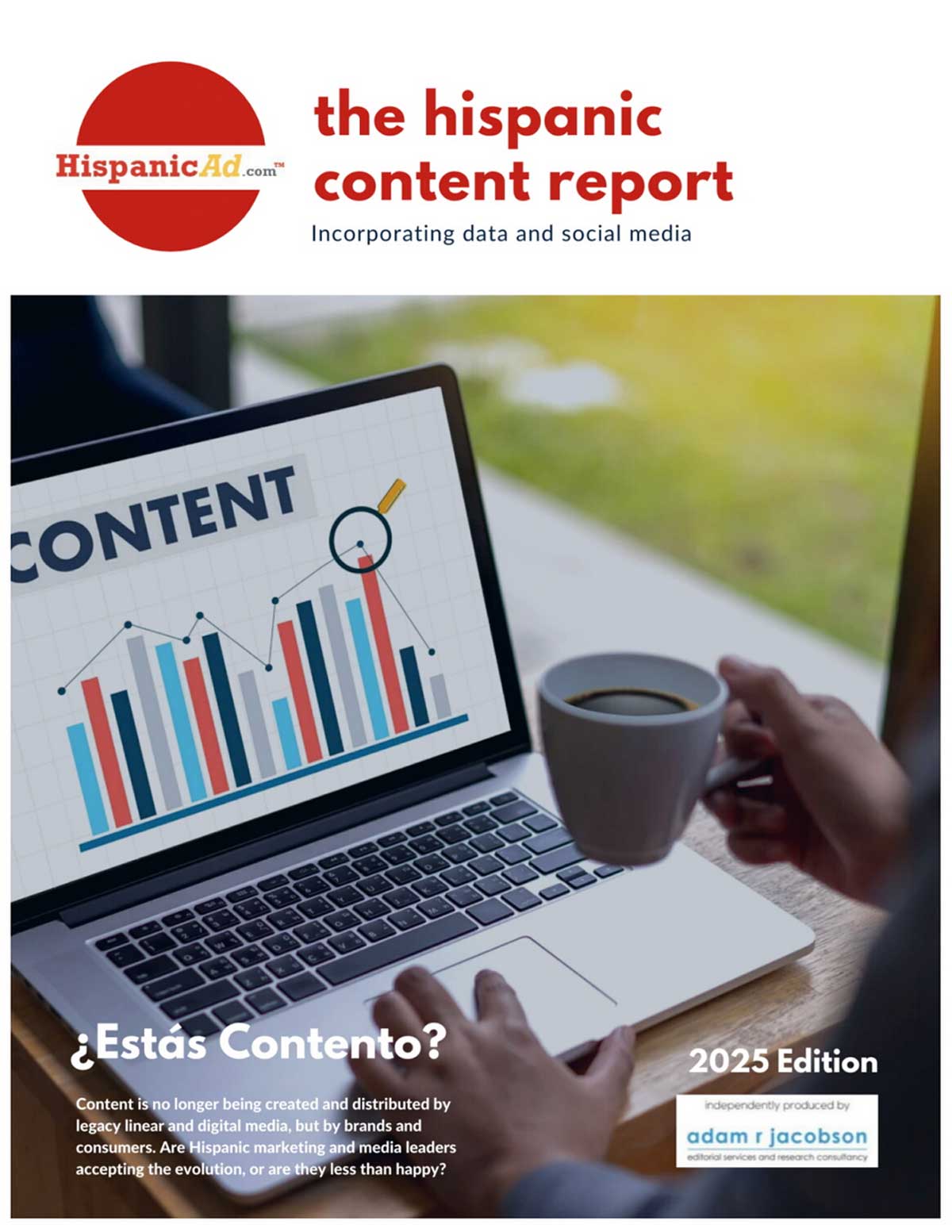![]() Data is hot — and if you’re not using for your marketing and advertising needs, then you’re likely going to be stumbling badly in the next 12-24 months.
Data is hot — and if you’re not using for your marketing and advertising needs, then you’re likely going to be stumbling badly in the next 12-24 months.
Research
Marketers: How To Succeed With Data [INSIGHT]
Hispanics Will Account for +40% of the Increase in U.S. Employment [INSIGHT]
 The Hispanic population will play an increasingly significant role in future U.S. employment growth, accounting for more than 40 percent of growth in the next five years and more than 75 percent between 2020 and 2034 – an increase of 11 million jobs out of an economy-wide gain of 14 million –according to a new study from IHS Inc..
The Hispanic population will play an increasingly significant role in future U.S. employment growth, accounting for more than 40 percent of growth in the next five years and more than 75 percent between 2020 and 2034 – an increase of 11 million jobs out of an economy-wide gain of 14 million –according to a new study from IHS Inc..
Millennials’ Views on Cars and Mobility [INSIGHT]
![]() A new research study by Portia Consulting and the University of California, Los Angeles sheds light on the surprising attitudes, preferences and behaviors of millennials about cars and mobility.
A new research study by Portia Consulting and the University of California, Los Angeles sheds light on the surprising attitudes, preferences and behaviors of millennials about cars and mobility.
We Are What We Eat [REPORT]
![]() Health and wellness are hot topics around the globe, and they have been for years.
Health and wellness are hot topics around the globe, and they have been for years.
Valentine’s Day Attitudes [INSIGHT]
 Depending on who you’re talking to at the time, it could be that you’ve heard February 14th is a great time of year to make that special someone understand just how much they mean to you… or that it’s an overly merchandized cog in an insidious corporate machine bent on monetizing as many days of the year as possible.
Depending on who you’re talking to at the time, it could be that you’ve heard February 14th is a great time of year to make that special someone understand just how much they mean to you… or that it’s an overly merchandized cog in an insidious corporate machine bent on monetizing as many days of the year as possible.
The Two Dimensions Of Data
![]() Data can be intimidating, but it doesn’t have to be. The fact is, most marketers were trained in marketing, which is more akin to psychology than it is to economics or mathematics. That was the case until the last few years. Now marketers are being tasked to be psychologists as well as mathematicians, technologists, statisticians and more. Pretty much the only job we don’t have to do is technical development — but just you wait, because that can’t be far behind.
Data can be intimidating, but it doesn’t have to be. The fact is, most marketers were trained in marketing, which is more akin to psychology than it is to economics or mathematics. That was the case until the last few years. Now marketers are being tasked to be psychologists as well as mathematicians, technologists, statisticians and more. Pretty much the only job we don’t have to do is technical development — but just you wait, because that can’t be far behind.
Kantar partners with comScore
 The alliance, which covers territories outside the US, is designed to deliver world class cross-media audience and campaign measurement capabilities by bringing together products, technology, data assets, research panels and relationships from both companies.
The alliance, which covers territories outside the US, is designed to deliver world class cross-media audience and campaign measurement capabilities by bringing together products, technology, data assets, research panels and relationships from both companies.
Motion Picture and Video Industry receipts exceed $80 Billion
![]() The U.S. Census Bureau released data today from the 2012 Economic Census showing that receipts for the nation’s motion picture and video industry – covering the entire process from production to projection − increased $1.2 billion (1.5 percent), from $79.8 billion in 2007 to $81.0 billion in 2012. These receipt totals include ticket and concession revenue.
The U.S. Census Bureau released data today from the 2012 Economic Census showing that receipts for the nation’s motion picture and video industry – covering the entire process from production to projection − increased $1.2 billion (1.5 percent), from $79.8 billion in 2007 to $81.0 billion in 2012. These receipt totals include ticket and concession revenue.
Do Americans Prefer Name-Brands or Store Brands? Well, That Depends. [INSIGHT]
 Americans often have their preferences. But just how often do Americans reach for “name-brand” products over the store brand options available? That depends on exactly what they’re reaching for.
Americans often have their preferences. But just how often do Americans reach for “name-brand” products over the store brand options available? That depends on exactly what they’re reaching for.
African-American Media Usage Outpaces Across Platforms
![]() African-Americans have a diverse approach to receiving content and information—they fully engage and connect through various mainstream and niche media outlets and platforms, and they consume more content than other groups on all fronts.
African-Americans have a diverse approach to receiving content and information—they fully engage and connect through various mainstream and niche media outlets and platforms, and they consume more content than other groups on all fronts.
Disrupting Aging During the “Age of Disruption” [INSIGHT]
 Last Friday’s HispanicAd News Alert publicized the results of a study that Ipsos conducted on behalf of CarMax, where the headline read, “Today’s Mid-Life Crisis Car Almost as Likely to be an SUV or a Sedan as a Sports Car – Make it Black …or Silver, or Blue, or Red!” The study examined the types of cars adults would purchase during a mid-life crisis, where they found that people are almost as likely to purchase an SUV or a sedan as the proverbial mid-life crisis vehicle, the sports car. While that may seem a bit surprising to many, the results actually reflect a mindshift happening in today’s society. By Louis Maldonado / Managing Director at expósito & Partner
Last Friday’s HispanicAd News Alert publicized the results of a study that Ipsos conducted on behalf of CarMax, where the headline read, “Today’s Mid-Life Crisis Car Almost as Likely to be an SUV or a Sedan as a Sports Car – Make it Black …or Silver, or Blue, or Red!” The study examined the types of cars adults would purchase during a mid-life crisis, where they found that people are almost as likely to purchase an SUV or a sedan as the proverbial mid-life crisis vehicle, the sports car. While that may seem a bit surprising to many, the results actually reflect a mindshift happening in today’s society. By Louis Maldonado / Managing Director at expósito & Partner
Smartphone Ownership hits Historic High among U.S. Millennial Moms [REPORT]
 Among the key findings, the study shows that millennial moms’ ownership of smartphones in the U.S. outpaces ownership of laptop and desktop computers for the first time, and that they are spending 35 percent more time online via their smartphones than online via laptop or desktop computers.
Among the key findings, the study shows that millennial moms’ ownership of smartphones in the U.S. outpaces ownership of laptop and desktop computers for the first time, and that they are spending 35 percent more time online via their smartphones than online via laptop or desktop computers.
Shopping Preferences and Habits of Men Provide Cues for Food and Beverage Marketers [INSIGHT]
 The study unveils the evolving shopping landscape of not only where people shop, but who is doing the shopping. Increasingly, men (who now compose 43 percent of primary shoppers) are shopping frequently and they now make just as many monthly store visits as women.
The study unveils the evolving shopping landscape of not only where people shop, but who is doing the shopping. Increasingly, men (who now compose 43 percent of primary shoppers) are shopping frequently and they now make just as many monthly store visits as women.
The Year in Sports Media Report: 2014 [REPORT]
![]() This year’s Year in Sports Media report highlights consumers’ global love of sports, which continues to grow. 2014 was a big year for sports, beginning with the Sochi Winter Olympics and then featuring one of the most exciting World Cups ever held.
This year’s Year in Sports Media report highlights consumers’ global love of sports, which continues to grow. 2014 was a big year for sports, beginning with the Sochi Winter Olympics and then featuring one of the most exciting World Cups ever held.
Treating Generations with a Personal Touch in Beauty Advertising
![]() From the latest nail polish trends to the hippest hair products or the toughest wrinkle fighters, women and men, young and old are shopping in the beauty aisle. In fact, 94% of all U.S. households buy beauty products, spending an average of $98 dollars each year.
From the latest nail polish trends to the hippest hair products or the toughest wrinkle fighters, women and men, young and old are shopping in the beauty aisle. In fact, 94% of all U.S. households buy beauty products, spending an average of $98 dollars each year.
Today’s Mid-Life Crisis Car Almost as Likely to be an SUV or a Sedan as a Sports Car – Make it Black …or Silver, or Blue, or Red!
 One in five (20%) respondents choose a sports car as the type of car they would want to buy if they were going through a mid-life crisis and were to buy a car, while nearly as many (17%) say a sports utility vehicle, and slightly fewer (15%) a sedan, according to a new poll of over 1,000 adults conducted by Ipsos Public Affairs on behalf of CarMax. Other choices include a convertible (12%), pickup truck (9%), hybrid (8%), crossover (5%), coupe (4%), minivan or van (4%), or some other type of car (6%).
One in five (20%) respondents choose a sports car as the type of car they would want to buy if they were going through a mid-life crisis and were to buy a car, while nearly as many (17%) say a sports utility vehicle, and slightly fewer (15%) a sedan, according to a new poll of over 1,000 adults conducted by Ipsos Public Affairs on behalf of CarMax. Other choices include a convertible (12%), pickup truck (9%), hybrid (8%), crossover (5%), coupe (4%), minivan or van (4%), or some other type of car (6%).
What To Expect From Boomers In 2015
 Boomers were as relevant as ever last year. I predicted they would drive economic expansion, create jobs, become more important to mainstream brands, and continue to rejuvenate the face of 50+. They didn’t disappoint.
Boomers were as relevant as ever last year. I predicted they would drive economic expansion, create jobs, become more important to mainstream brands, and continue to rejuvenate the face of 50+. They didn’t disappoint.
Using Competitive Analysis to Identify Brand Growth Opportunities with Online U.S. Hispanics [PART 1]
![]() More and more, brands are realizing that the U.S. Hispanic audience is large, growing, tech savvy, and particularly receptive to online marketing. This presents a huge opportunity for many brands to drive growth. One question we hear often from brands ready to venture into the Hispanic digital market: Where do we start?
More and more, brands are realizing that the U.S. Hispanic audience is large, growing, tech savvy, and particularly receptive to online marketing. This presents a huge opportunity for many brands to drive growth. One question we hear often from brands ready to venture into the Hispanic digital market: Where do we start?
In this two-part series, we explore three critical assessments brands can perform to determine where opportunity lies for growth with a Hispanic audience.
Analyze Your Web Presence to Identify Growth Opportunities with Online U.S. Hispanics [PART 2]
![]() In this two-part series, we explore three critical assessments brands can perform to determine where opportunity lies for growth with a Hispanic audience. Part 1, covering Competitive Analysis, can be found here. Read on for Part 2, covering brand-owned Website Audit and Social Channel Evaluations.
In this two-part series, we explore three critical assessments brands can perform to determine where opportunity lies for growth with a Hispanic audience. Part 1, covering Competitive Analysis, can be found here. Read on for Part 2, covering brand-owned Website Audit and Social Channel Evaluations.
Dramatic Increase In Podcasting Consumption
 In the Spring 2014 Share of Ear℠ study (a syndicated research series from Edison Research), we took a first look at how much of the total audio consumed by Americans was devoted to podcasts. Compared to the entire audio universe–every available minute of radio, Internet radio, music files, Satellite and more–podcasts occupied a single digit percentage of America’s total audio listening. But when we looked specifically at only those Americans who listen to podcasts, we got a different story–if you listen to podcasts, you listen to a lot of podcasts.
In the Spring 2014 Share of Ear℠ study (a syndicated research series from Edison Research), we took a first look at how much of the total audio consumed by Americans was devoted to podcasts. Compared to the entire audio universe–every available minute of radio, Internet radio, music files, Satellite and more–podcasts occupied a single digit percentage of America’s total audio listening. But when we looked specifically at only those Americans who listen to podcasts, we got a different story–if you listen to podcasts, you listen to a lot of podcasts.




























